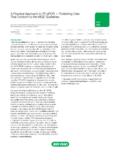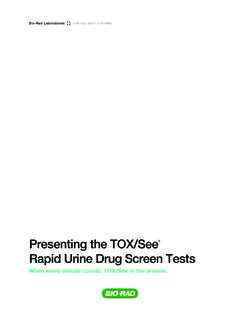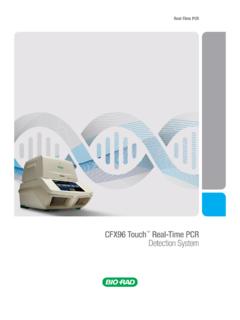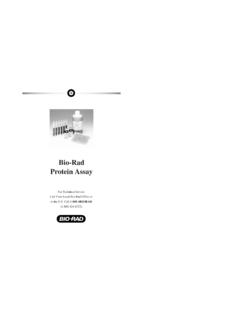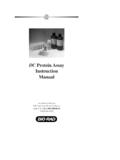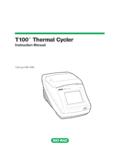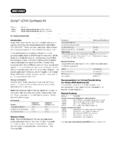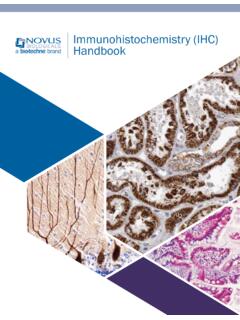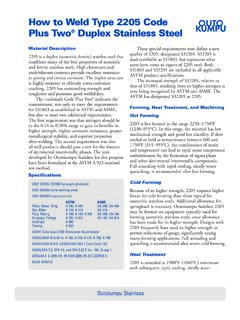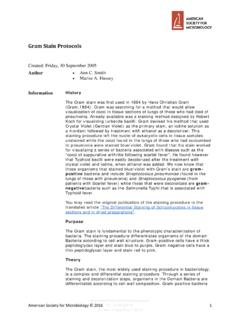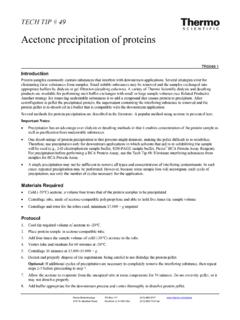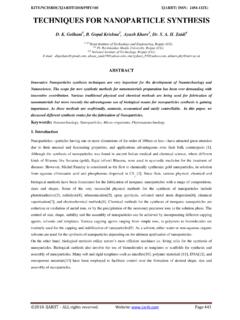Transcription of Protein Sample Preparation - Bio-Rad
1 If Protein phosphorylation is to be studied, include phosphatase inhibitors such as okadaic acid, calyculin A, and vanadate. When working with a new Sample , use at least two different cell disruption protocols and compare the Protein yield (by Protein assay) and qualitative Protein content (by SDS-PAGE) Optimize the power settings of mechanical rupture systems and incubation times for all lysis approaches. Mechanical cell lysis usually generates heat, so employ cooling where required to avoid overheating of the Sample Following cell disruption, check the efficacy of cell wall disruption by light microscopy and centrifuge all extracts extensively (20,000 g for 15 min at 15 C) to remove any insoluble material; solid particles may block the pores of the electrophoresis gelLysis (Cell Disruption) Suspend ~1 mg (wet weight) pelleted cells in ~10 l 1 SDS-PAGE Sample buffer for a Protein concentration of 3 5 g/ l.
2 If disrupted in liquid nitrogen, tissue samples like liver biopsies and plant leaves contain 10 20% and 1 2% Protein , respectively To diminish endogenous enzymatic activity: Disrupt the Sample or place freshly disrupted samples in solutions containing strong denaturing agents such as 7 9 M urea, 2 M thiourea, or 2% SDS. In this environment, enzymatic activity is often negligible Perform cell disruption at low temperatures to diminish enzymatic activitiy Lyse samples at pH >9 using either sodium carbonate or Tris as a buffering agent in the lysis solution (proteases are often least active at basic pH) Add a chemical protease inhibitor to the lysis buffer. Examples include phenylmethylsulfonylfluoride (PMSF), aminoethylbenzylsulfonylfluoride (AEBSF), tosyllysinechloromethylketone (TLCK), tosylphenylchloromethyletone (TPCK), ethylenediaminetetraacetic acid (EDTA), benzamidine, and peptide protease inhibitors (for example, leupeptin, pepstatin, aprotinin, bestatin).
3 For best results, use a combination of inhibitors in a protease inhibitor TipsKeep the Sample Preparation workflow simple (increasing the number of Sample handling steps may increase variability). Protocol Protein Sample PreparationBulletin 6194 Life ScienceGroupBulletin 6194 Rev A US/EGBio-Rad Laboratories, 1111 Sig 1211 Web site USA 800 424 6723 Australia 61 2 9914 2800 Austria 01 877 89 01 Belgium 09 385 55 11 Brazil 55 11 5044 5699 Canada 905 364 3435 China 86 21 6169 8500 Czech Republic 420 241 430 532 Denmark 44 52 10 00 Finland 09 804 22 00 France 01 47 95 69 65 Germany 089 31 884 0 Greece 30 210 9532 220 Hong Kong 852 2789 3300 Hungary 36 1 459 6100 India 91 124 4029300 Israel 03 963 6050 Italy 39 02 216091 Japan 03 6361 7000 Korea 82 2 3473 4460 Mexico 52 555 488 7670 The Netherlands 0318 540666 New Zealand 64 9 415 2280 Norway 23 38 41 30 Poland 48 22 331 99 99 Portugal 351 21 472 7700 Russia 7 495 721 14 04 Singapore 65 6415 3188 South Africa 27 861 246 723 Spain 34 91 590 5200 Sweden 08 555 12700 Switzerland 061 717 95 55 Taiwan 886 2 2578 7189 Thailand 800 88 22 88 United Kingdom 020 8328 2000 Protein
4 Solubilization Solubilize proteins in a buffer that is compatible with the corresponding electrophoresis technique Dissolve pelleted Protein samples in 1 Sample buffer Dilute dissolved Protein samples with Sample buffer stock solutions to a final Sample buffer concentration of 1 Perform a Protein quantitation assay to determine the amount of total Protein in each Sample . Use a Protein assay that is tolerant to chemicals in your samples. For samples in Laemmli Sample buffer, for example, use the DC or RC DC Protein assays, which can tolerate up to 10% detergent Dilute or concentrate samples as needed to yield a final Protein concentration of > mg/ml (omit the Protein assay if Sample amount is limited) Use Protein extracts immediately or aliquot them into appropriately sized batches and store them at 70 C to avoid freeze-thaw cycles For long-term Sample storage, store aliquots at 70 C; avoid repeated thawing and freezing of Protein samples Highly viscous samples likely have a very high DNA or carbohydrate content.
5 Fragment DNA with ultrasonic waves during Protein solubilization or by adding endonucleases like Benzonase. Use Protein precipitation with TCA/ acetone (for example, with the ReadyPrep 2-D cleanup kit) to diminish carbohydrate content When a Sample Preparation protocol calls for a dilution, the two parts are stated like a ratio, but what is needed is a fraction. For example, Dilute 1:2, means to take 1 part of one reagent and mix with 1 part of another, essentially diluting the part by one half. Dilute 1:4, means to take 1 part and mix with 3 parts, making a total of 4 parts, diluting the part by a for PAGE Prepare SDS-PAGE Sample buffer without reducing agent, then aliquot and store it at 70 C Prepare reducing agent fresh, and add it to SDS-PAGE Sample buffer immediately before use Dissolve dry Protein samples directly in 1 Sample buffer; prepare other Protein Sample such that the final Sample buffer concentration is 1 Incubate samples in Sample buffer at 95 C for 5 min (or at 70 C for 10 min) after addition of Sample buffer for more complete disruption of molecular interactions When preparing SDS-PAGE Sample buffer, use either 5% (~100mM) 2-mercaptoethanol (bME) or 5 10 mM dithiothreitol (DTT) Preferably, the final Protein concentration in the Sample solution for 1-D electrophoresis should not be < mg/ml.
6 Keep in mind that the final Sample concentration should also be consistent with the sensitivity of your detection method as well as with the complexity of the Sample . Higher sensitivity detections can be used with lower Sample concentrations. In general, the more complex samples require higher Sample concentration for analysisThis is an excerpt from Bio-Rad s comprehensive Electrophoresis Guide (Bulletin 6640).


